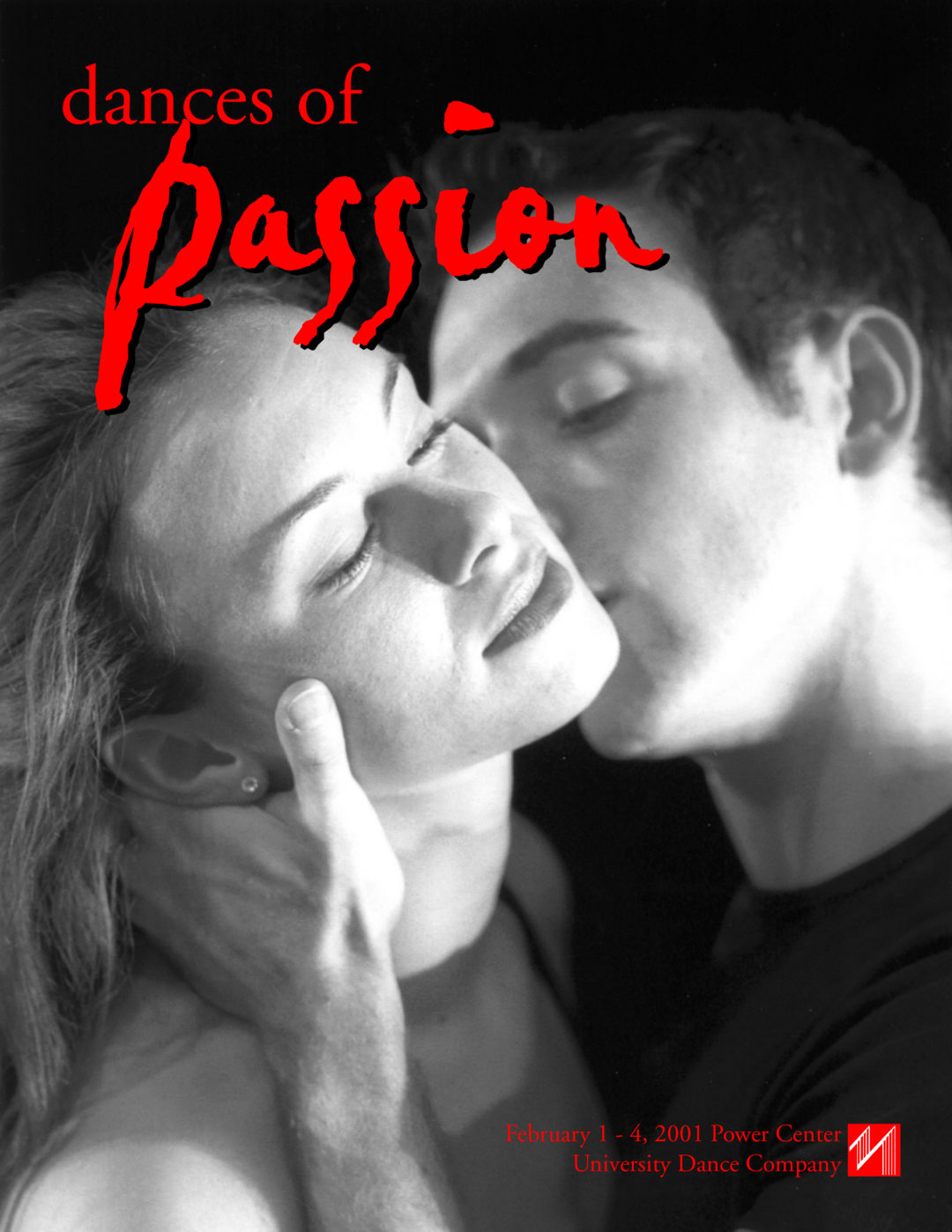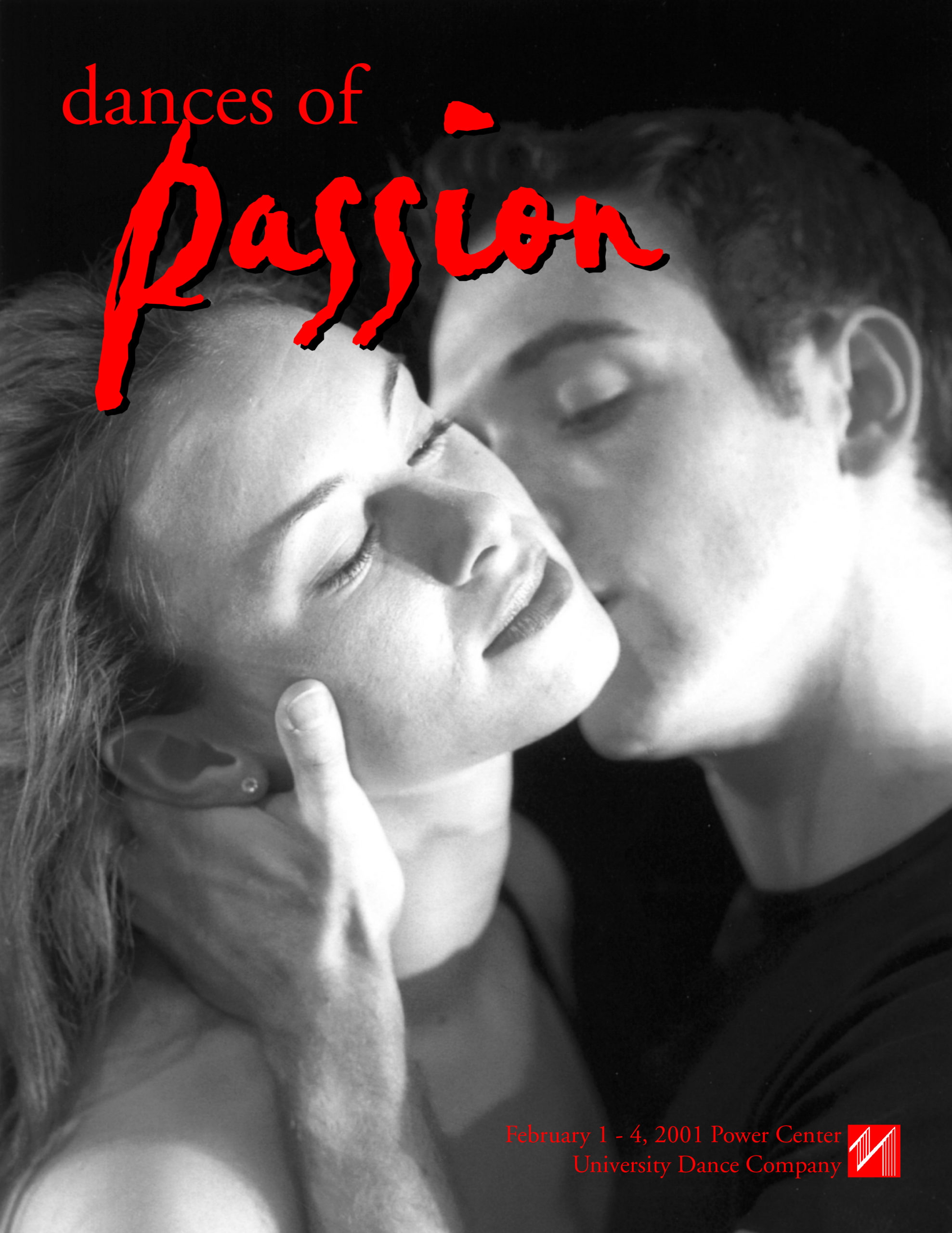Dances of Passion
Choreography by guest artist Carlos Orta with faculty artists Bill DeYoung, Sandra Torijano, and Robin Wilson
Department of Dance
February 1-4, 2001 • Power Center
Internationally renowned dancer and choreographer Carlos Orta joins the Dance Department to create Breaking the Silence, a somber and masterful dance based on Pablo Picasso’s famed wartime mural Guernica. “I first saw the mural two years ago on a trip to Madrid,” states Orta. “The power of the artist’s work drew me back every day for a week, each time discovering a new element in the mural.” Orta’s dance recreates various tableaus from the mural, utilizing the dominant figures of the Mother, horse, and bull. The work is broken into “rooms” similar to the painting. Using a combination of bodies and sticks, Orta builds on the cubist forms that Picasso used to convey the passions of war and hatred. Underscoring this highly spiritual work is the music of Paco Pena, Miles Davis, and Rene Aubry.
Teaming up for the next dance called Rauxa (pronounced Row – sha) are Bill DeYoung and Sandra Torijano. Drawing on their impressions of Barcelona and the Catalan region of Spain after a sabbatical there, the pair has created a dance celebrating the juxtaposition of separate realities. “Two things guide a Catalan: seny – common sense and rauxa – creative chaos,” states DeYoung. “The community recognizes the need for outlets of this chaos through a constant stream of festivals and protests. These layers are evident in all cities of the world including our hometown, but we notice them more when we travel. We all strive for what the Spanish call duende – that shimmering moment in artistic expression when passion is not held in check. The opportunities to experience those shimmering moments and the times when we regress away to take care of the business of life become all the gradations of passion.” DeYoung and Torijano have pulled music from all areas of Spain, from new works of techno dance music to more traditional flamenco.
Choreographer Robin Wilson celebrates the 100th birthday of Louis Armstrong in Hot Five Rondo. “Armstong was one of the greatest innovators of Jazz whose profound influence is still evidenced today. His music celebrates life in a very passionate, joie de vivre way,” states Wilson. Using vernacular forms of dance from the 1930s in combination with a film noir story of a crime of passion, Wilson weaves a tapestry of murder, mayhem and melody. “The work is a tribute to black artists of the ’30s, such as the ballroom couple Norton and Margo and the Nickolas Brothers, who helped create and popularize the social dances of the period, like soft-shoe, hoofing, the Charleston, the Suzy Q, the Shorty George, and the Lindy Hop. Oftentimes these dances are devalued because they are part of the popular vernacular, but people forget the incredible technique and skill needed for the dances.” Wilson has set her dance to such Armstrong favorites as “Mahogany Hall Stomp,” “Stompin’ at the Savoy,” and “I’ve Got a Heart Full of Rhythm.”
Repertoire & Performers
[accordion title=”Rauxa”]
Rauxa (pronounced ROW-sha) is a Catalan word that refers to the wild, irresponsible and spontaneous side of the personality.
Choreographers: Bill DeYoung, Sandra Torijano
Scenic & Costume Designer: Jeff Bauer
Lighting Designer: Mary Cole
Music Collage: Bill De Young
Sound Mixing: Chris Konovaliv
Rehearsal Captain: Gena T. Buhler
Stage Managers: Kelly K. Irwin, Nancy Uffner
Ensemble
Megan Baker, Eric Blair, Julie Blume, Gena T. Buhler, Tracee Chin, Melissa Choate, Nasim Deylami, Darren C. Dunn, Lillian Fincher, Angela Marie Gallo, Svetlana Gladycheva, Nathan Greenwood, Megan Johnson, Deborah Karp, Susan Kellerman, Jennifer Kosky, Tomoko Kurokawa, Elizabeth Maderal, Melissa Mallinson, Ashley Marshall, Rachel McKinstry, Nicole A. Palczynski, Elizabeth Riga, Alexandra Sadinoff, Elizabeth Schmidt, Abigail Sebaly, Nicole Stasunas, Janna V. Van Hoven, Beth Wielinski
I. Nicole A. Palczynski and ensemble
II. Janna V. Van Hoven and ensemble
III. Eric Blair, Svetlana Gladycheva, and ensemble
IV. Eric Blair
V. Ensemble and featured solos: Tomoko Kurokawa, Susan Kellerman, Janna V. Van Hoven, Deborah Karp, Melissa Mallinson, Tracee Chin, Nicole A. Palczynski
VI. Tomoko Kurokawa
VII. Nicole A. Palczynski, Rachel McKinstry, and ensemble
VIII. Darren C. Dunn, Melissa Mallinson, Deborah Karp
IX. Darren C. Dunn and ensemble
X. Elizabeth Riga, Nathan Greenwood, Eric Blair, Rachel McKinstry, Darren C. Dunn, Nicole A. Palczynski
XI. Nicole A. Palczynski, Rachel McKinstry, and ensemble
[/accordion][accordion title=”Hot Five Rondo”]
To Louis Armstrong, in the 100th year of his birth. One of the foremost musicians of the 20th century, jazz pioneer Louis “Satchmo” Armstrong was born in New Orleans on August 4, 1901. Throughout the 1920s, Armstrong played with a variety of notable band leaders including King Oliver and Fletcher Henderson. Forming his own bands, the Hot Five and Hot Seven, he would earn the nickname “Satchmo” (short for “Satchel Mouth”) thanks to his huge, trumpet-inflated cheeks. Switching from coronet to trumpet in 1927, he popularized the art of “scat” singing with the song “Heebies Jeebies.” Due to his classic exposition of material found in “West End Blues,” Armstrong single-handedly developed jazz into a “classic” genre, and congealed the elements of dixieland, blues and ragtime into a new and distinctly American form. With the advent of bebop, Armstrong broke up his big band, founded a sextet called the All-Stars, a Dixieland/swing group with a humorous stage-presence, and continued touring until his death in New York on July 6, 1971.
Hot Five Rondo pays tribute to two great artistic expressions that were emerging in the Thirties – the great traditions of dance and music by African-American artists, and the emerging literary genre of crime fiction which later evolved into the film genre Film Noir. From Mama Lu Parks and Whitey’s Lindyhoppers, to Norton and Margot, the most famous black ballroom dance duo of their time, the Nickolas Brothers, the Copasetics, Jenny LeGon, and countless others, Hot Five Rondo celebrates the indomitable spirit of the many dancers who gathered in dance halls and night clubs from Harlem to Kansas City.
Choreographer: Robin Wilson
Copasetics Soft Shoe: Susan Filipiak
Composer/Music Editing: Chris Peck
Scenic & Costume Designer: Jeff Bauer
Lighting Designer: Mary Cole
Stage Managers: Kelly K. Irwin, Nancy Uffner
Filmnoir
Damon Dobson, Private Dick: Eric Blair
Della, The Double-Dealing, Dangerous Dame: Katherine Whitaker
Diane: Anne Falardeau
Duffy, Police Lieutenant: Melissa Beck
Boys in Blue: Wendy Birndorf, Kari Wall
Henchmen: Melissa Beck, Wendy Birndorf, Kelly Bowker, Anne Falardeau, Kari Wall, Katherine Whitaker
Suite Armstrong
Beans and Cornbread: Nicolle Gauvin, Melissa Norwood, Einnaf Smith, Holly Furgason, Shannon Perlotto, Maia McKinney, Anna Lee Beard, Kirsten L. Seacor, Jennifer Russo, Justin House, David Knapp, Michael Woodberry-Means
Hot Twelve: Bria Bergman, Kelly Bowker, Jennifer Chard, Alissa Harrison, Pamela Horning, Justin House, Kristen Hutchinson, David Knapp, Natalie Lacuesta, Cornelia McPherson, Ryan Myers, Jennifer Seguin
Sweetpea: Jodi Leigh Allen, Abigail Bowen, Veronica Chapp, Mary Farris, Leslie Lamberson, Ricki Mason, Shannon Perlotto, Kirsten L. Seacor
Mahogany Hall Stomp, Finale: Full Suite Armstrong Ensemble
I. Filmnoir
Scene One: The End (Dead Dame)
Scene Two: Boy Meets Girl
Scene Three: Under the Streetlamp
II. Suite Armstrong – Mahogany Hall Stomp
III. Filmnoir
Scene Four: The Dames
Scene Five: Murder and Mayhem
IV. Suite Armstrong – Beans and Cornbread:
Copasetic Soft Shoe, Bustin’ Out, Swingin’ at the Savoy
V. Filmnoir
Scene Six: The Henchmen
VI. Suite Armstrong – Hot Twelve
VII. Filmnoir
Scene Seven: Betrayal
VIII. Suite Armstrong
Sweetpea
Finale
IX. Filmnoir
Scene Seven: The End
[/accordion][accordion title=”Breaking the Silence”]
This dance is based on Pablo Picasso’s masterwork “Guernica.” On April 26, 1936, German bombers allied with Generalismo Francisco Franco during the Spanish Civil War wiped out the Basque village of Guernica. Stunned by the news of the bombing of the town (from which the painting takes its title), Picasso painted a huge canvas in stark black and white. Its main subjects are the horse and the bull – from the world of bullfighting – and the mother fleeing with her dead child in her arms. The painting was commissioned by the government of the Spanish Republic for the Spanish Pavilion at the 1937 Paris World Fair. Housed for safekeeping during Spain’s fascist regime at Museum of Modern Art in New York City, the mural is currently exhibited at the Museo Nacional Centro de Arte Reina Sofia in Madrid, Spain.
Choreographer: Carlos Orta
Rehearsal Assistants: Roel Seeber, Gay Delanghe
Music Editing: Chris Konovaliv, Christian Matjias
Scenic & Costume Designer: Jeff Bauer
Lighting Designer: Mary Cole
Stage Managers: Kelly K. Irwin, Nancy Uffner
Featured Dancers (Thursday-Saturday/Friday-Sunday)
Bull: Darren C. Dunn/Jodi Leigh Allen
Spain: Nicole A. Palczynski/Elizabeth Riga
Vision: Leslie Lamberson/Mary Farris
Church: Jodi Leigh Allen
Horse: Elizabeth Riga/Eric Blair
Matador: Michael Woodberry-Means
Ensemble
Jodi Leigh Allen, Eric Blair, Gena T. Buhler, Darren C. Dunn, Mary Farris, David Knapp, Tomoko Kurokawa, Leslie Lamberson, Maia McKinney, Nicole A. Palczynski, Elizabeth Riga, Michael Woodberry-Means
[/accordion]
Sponsors
The School of Music acknowledges the generosity of McKinley Associates, Inc. whose support has helped make this production possible.


